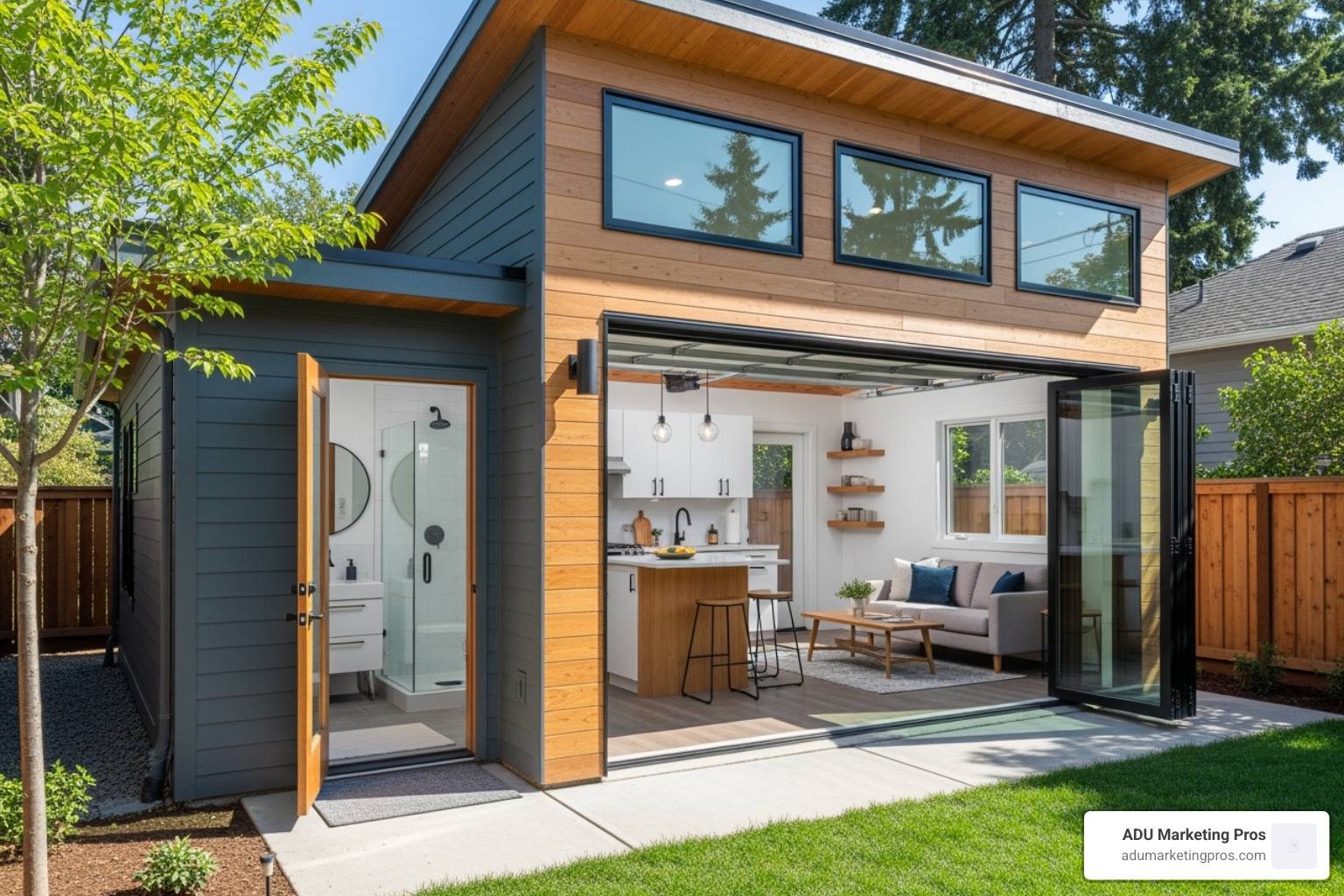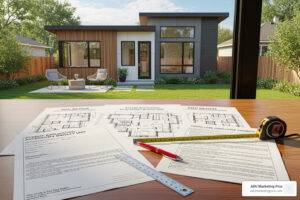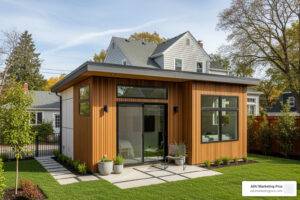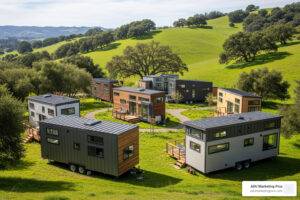Why Smart Homeowners Are Converting Garages to ADUs
In the face of California’s persistent housing shortage and soaring property values, homeowners are discovering a powerful financial tool hiding in plain sight: the garage. Converting this underutilized space into a legal, rentable Accessory Dwelling Unit (ADU) has become one of the most strategic home improvements available. The cost to convert your garage into an ADU typically ranges from $50,000 to $150,000, or about $150-$300 per square foot. This investment transforms a space for dusty boxes and forgotten hobbies into a high-performing financial asset, capable of significantly boosting your property value and generating substantial rental income.
Here’s a quick overview of what you can expect:
- Single-car garage conversion (approx. 200 sq ft): $50,000-$90,000
- Two-car garage conversion (approx. 400 sq ft): $80,000-$150,000
- Average cost per square foot: $150-$300
- Typical Los Angeles average: $80,000-$125,000
- Payback period through rental income: 5-7 years
A garage conversion offers one of the smartest returns on investment in real estate today. A well-executed project can increase your property value by 20-30% and generate $1,200-$3,000+ in monthly rent, far outpacing the cost and timeline of building a new detached ADU from the ground up. However, the final budget is a complex equation involving more than just construction. Soft costs like permits and design fees, hard costs for labor and materials, and your personal choices in finishes can all significantly impact your total ADU conversion cost. This comprehensive guide will break down every potential expense, empowering you to make informed decisions, budget accurately, and avoid costly surprises on your journey to unlocking your property’s full potential.
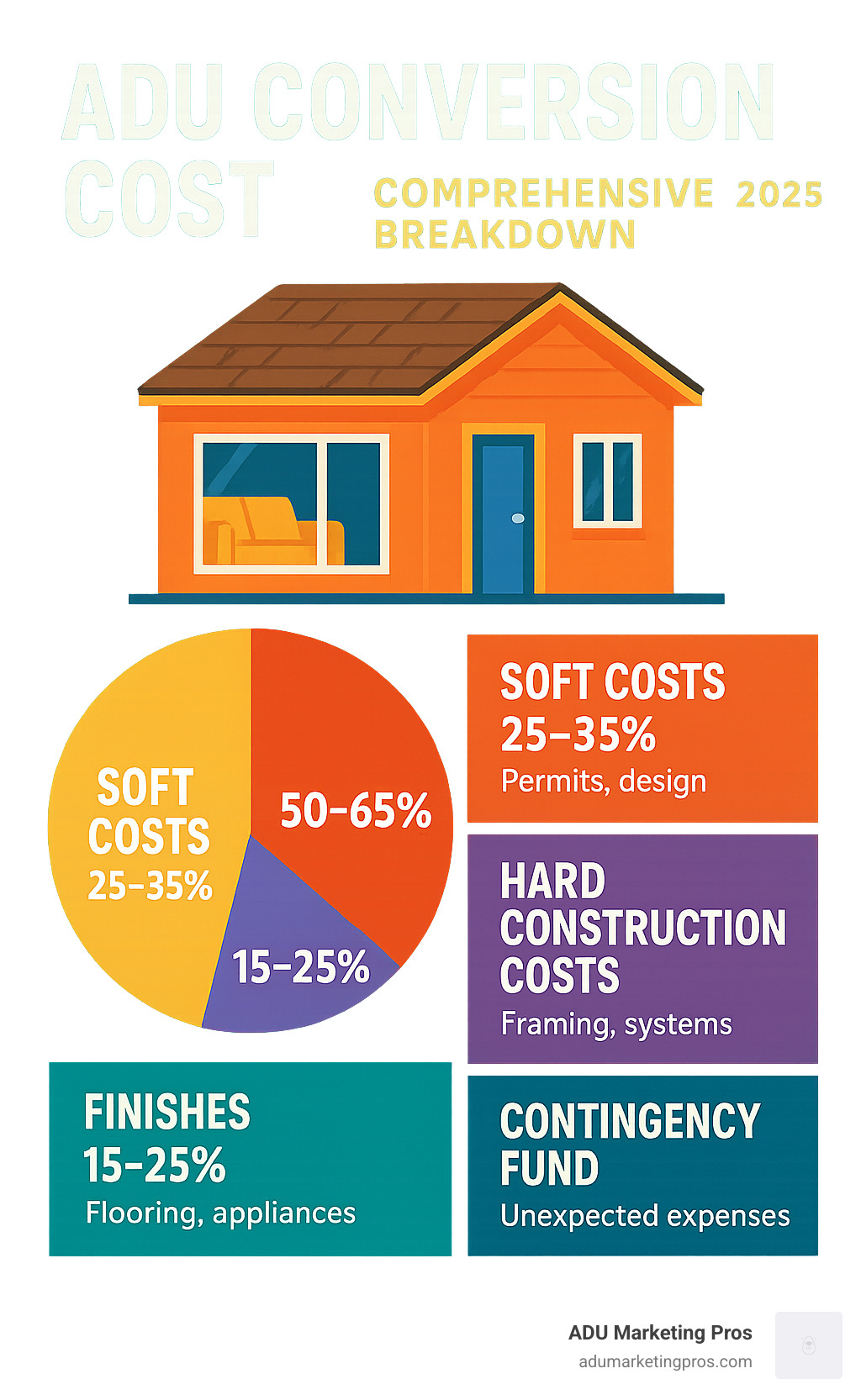
The Bottom Line: Average ADU Conversion Costs
The average ADU conversion cost for a standard garage ranges from $50,000 to $150,000. This wide spectrum is influenced by critical factors like your garage’s size, its current structural condition, and your geographic location. The cost per square foot generally falls between $150 to $300, which is a compelling figure when compared to building a new detached ADU. A new build often starts at $300 per square foot and can easily exceed $600, making conversions significantly more budget-friendly because you already have a foundation, walls, and a roof—the most expensive structural components of any new build.
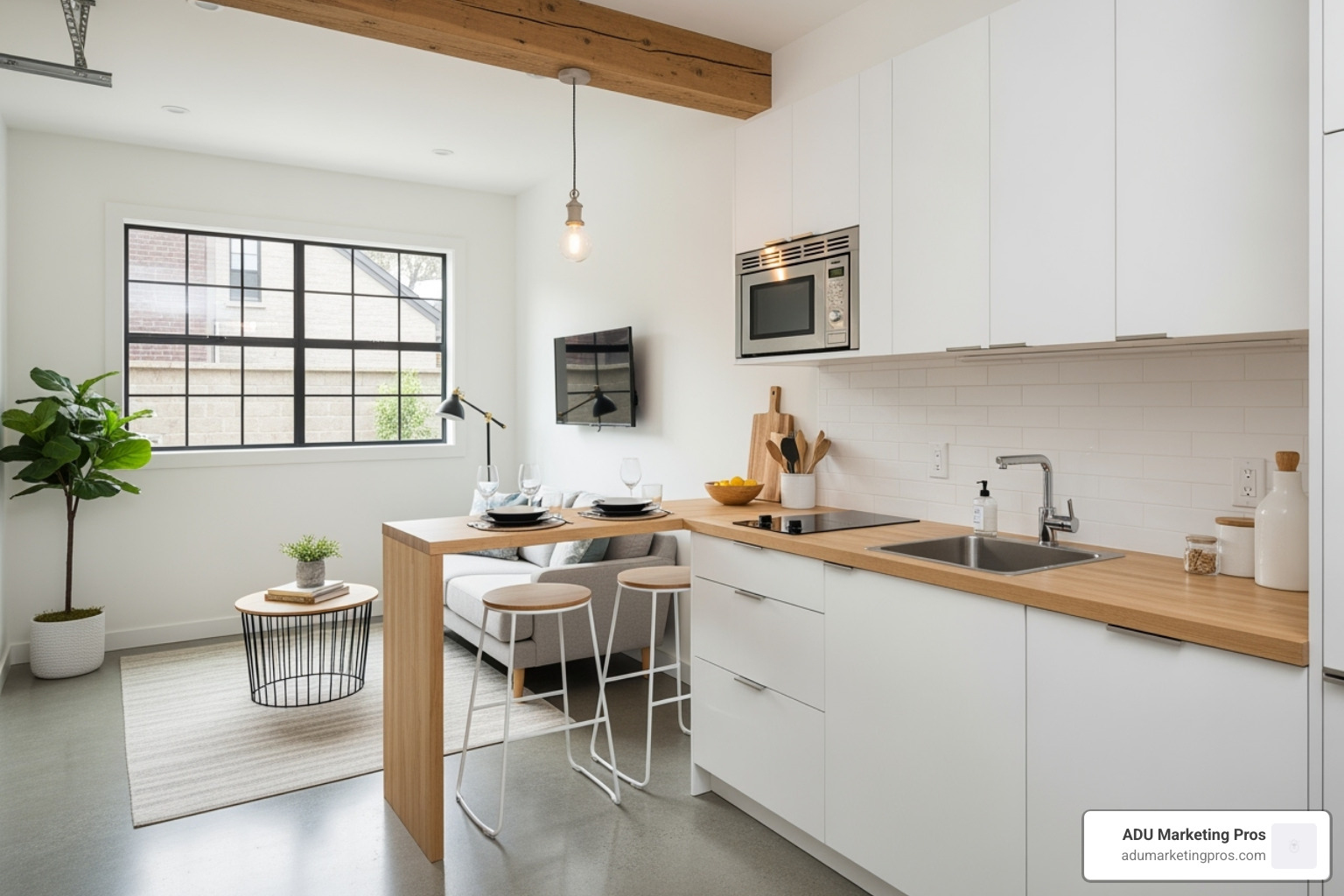
Understanding the Average ADU Conversion Cost
The type of garage you have is a primary cost driver. Attached garage conversions are generally more affordable, typically running $60,000 to $90,000. Their proximity to the main house allows them to more easily and cheaply tap into existing utility lines (water, sewer, and electrical), saving thousands on trenching and connection fees.
Detached garage conversions carry a higher price tag, often starting around $110,000 for a 460-square-foot unit. The increased cost is due to the need for standalone utility connections, which requires extensive trenching across your property to connect to the main lines. Furthermore, detached structures may require more significant structural and seismic upgrades to be brought up to current residential code. In a competitive market like Los Angeles, our research on Los Angeles ADU Cost shows a typical range of $80,000 to $125,000, but high-end projects with premium finishes or significant structural work can easily climb from $150,000 to $375,000.
For a more precise budget tailored to your property, our ADU Cost Calculator can provide a detailed estimate based on your specific location, garage size, and project details.
Cost Ranges by ADU Size
While it’s intuitive that larger ADUs cost more overall, the price per square foot often decreases as the size increases. This is because fixed costs—such as design fees, permits, and utility connections—are spread over a larger area, making each square foot incrementally cheaper to build.
- Studio ADUs (200-400 sq ft): Typically converted from single-car garages, these efficient units are ideal for a single renter or as a home office. Expect costs to range from $50,000 to $90,000.
- One-bedroom ADUs (400-600 sq ft): Often created from two-car garages, these are the most popular type of conversion. They offer a comfortable living space with a separate bedroom, living area, kitchen, and bathroom, costing between $80,000 and $125,000.
- Two-car garage conversions (300-400 sq ft): These projects generally fall between $100,000 to $125,000, providing a flexible layout that can be configured as a large studio or a compact one-bedroom unit.
- Larger conversions (750-1200 sq ft): For homeowners with oversized garages or those planning to expand the existing footprint, costs can range from $112,500 to $360,000. These larger units can accommodate two bedrooms and offer significant rental income potential. Exploring ADU Plans with Garage can provide inspiration for maximizing both space and value in these larger projects.
Beyond the Build: A Detailed Cost Breakdown
A project’s total ADU conversion cost is composed of much more than just construction materials. It’s a mosaic of “soft costs” (the planning and paperwork) and “hard costs” (the physical build). Understanding this full breakdown is the most critical step in creating a realistic budget and avoiding financial stress. For a deeper dive into the nuances of budgeting, see our guide to ADU Building Costs.
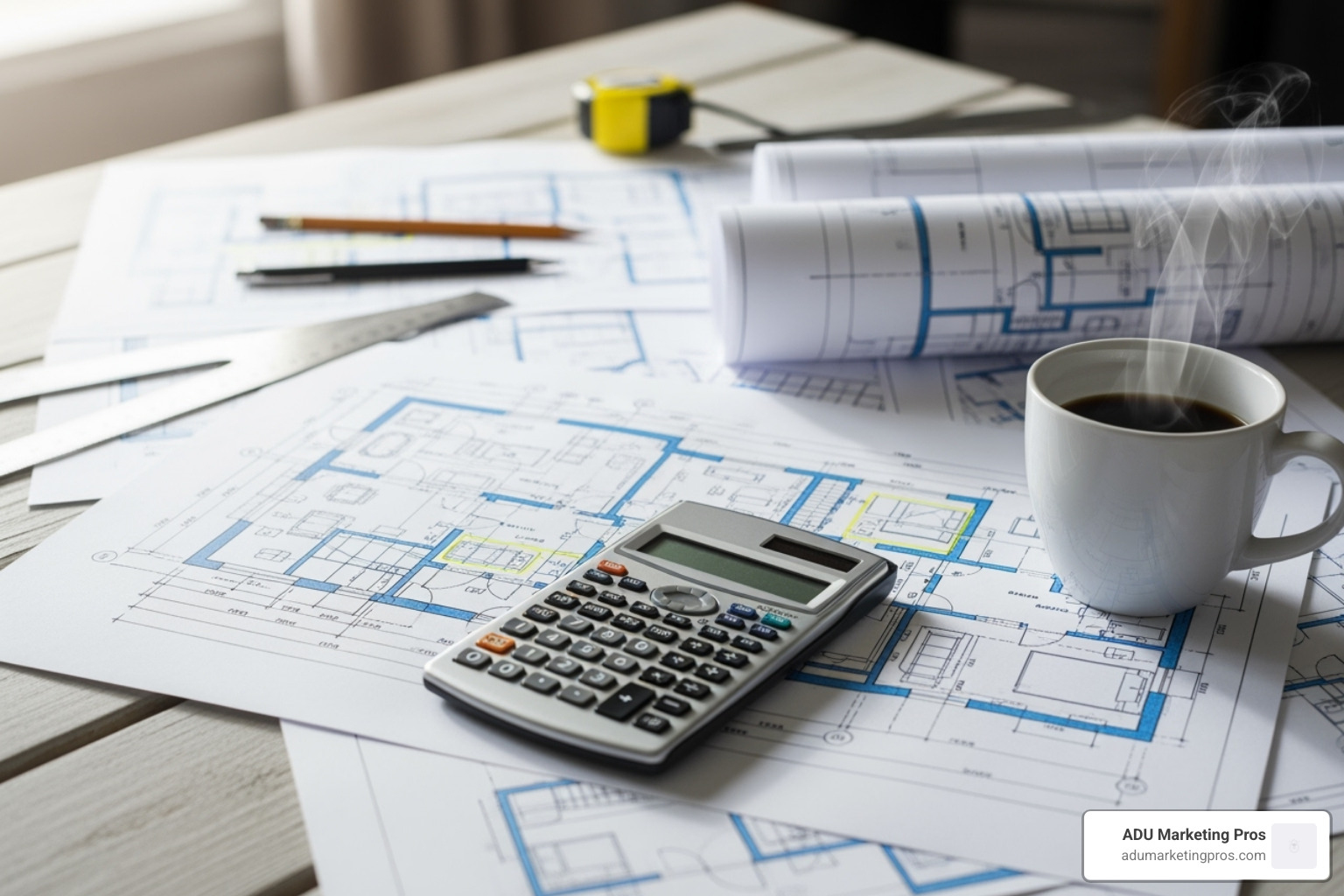
Soft Costs: The Planning & Paperwork Phase (10-20% of Budget)
Before a single hammer swings, you’ll invest in the crucial planning phase. These costs ensure your project is legal, safe, and well-designed.
- Design Fees ($2,000 – $30,000): An architect or designer is essential for creating compliant, functional plans. Fees can be a flat rate or 10-15% of the total project cost. This includes creating blueprints for layout, elevations, and construction details. Explore options in our ADU Building Plans resource.
- Engineering Fees ($3,000 – $8,000): A structural engineer must assess the existing garage and design necessary upgrades to the foundation, framing, and roof to meet residential building and seismic codes. This is a non-negotiable step for safety.
- Permit Fees ($2,000 – $8,000): In California, you’ll need a package of permits, including building, electrical, plumbing, and mechanical (HVAC). Los Angeles averages around $3,000 for a standard conversion. Learn more about navigating the process with our guide to ADU Permit Cost California.
- Other Fees ($0 – $20,000+): This category can include several items. Impact fees (for schools, parks, etc.) are typically waived for ADUs under 750 sq ft but can cost $2,000-$14,000 for larger units. Utility connection fees for new water and power meters can range from a few thousand to over $20,000, depending on the provider and the distance from the main lines. You may also need a soil report ($1,000-$3,000) if you are expanding the foundation.
Hard Costs: From Foundation to Finishes (60-75% of Budget)
Hard costs represent the bulk of your budget, covering all labor and materials for the physical construction.
- Foundation & Framing ($7,000 – $25,000): Your existing concrete slab must be inspected for cracks and levelness. Repairs, moisture proofing, and potentially pouring a new layer of concrete can cost $2,000-$10,000. Framing new interior walls, closets, and reinforcing headers for new windows and doors costs an additional $5,000 to $15,000.
- Major Systems (Plumbing, Electrical, HVAC) ($5,500 – $15,000): New plumbing for a kitchen and bathroom typically costs $1,500 to $4,000, but this can increase if significant trenching is needed for a detached unit. Electrical work, including a new subpanel and wiring, runs $1,000 to $3,000. An energy-efficient mini-split HVAC system is the most popular choice and costs $2,000 to $8,000 installed.
- Exterior Work ($5,000 – $20,000+): The garage exterior must be upgraded to look like a home. This includes new windows and doors, repairing or replacing siding, and a fresh coat of paint. If the existing roof is old, a replacement can add $10,000 or more to the project.
- Insulation & Drywall ($3,000 – $7,000): Proper insulation is key for comfort and energy efficiency, potentially cutting utility costs by 10-50% according to the U.S. Department of Energy. This includes insulating walls and the ceiling, followed by hanging and finishing drywall.
- Finishes & Fixtures ($10,000 – $50,000+): This is the most variable category. Costs depend entirely on your selections for flooring, cabinetry, countertops, appliances, lighting, and bathroom fixtures. You can choose budget-friendly vinyl flooring and laminate countertops or opt for high-end hardwood and quartz.
Don’t Forget Contingency & Cleanup (10-15% of Budget)
No project goes exactly as planned. A 10-15% contingency fund is essential for covering unexpected issues like hidden rot, termite damage, or supply chain price hikes. This financial safety net prevents delays and stress. Also, budget for post-construction cleanup ($140-$710) and waste disposal ($400-$1,400) to get your new ADU move-in ready.
What Drives the Price Tag? Key Factors Influencing Your ADU Conversion Cost
Beyond the basic estimates, your final ADU conversion cost will be determined by a unique combination of factors related to your property, your local jurisdiction, and your personal taste. Acknowledging these variables early in the process is key to developing a realistic budget. Understanding these nuances is central to grasping the full picture of ADU Construction Cost in California.
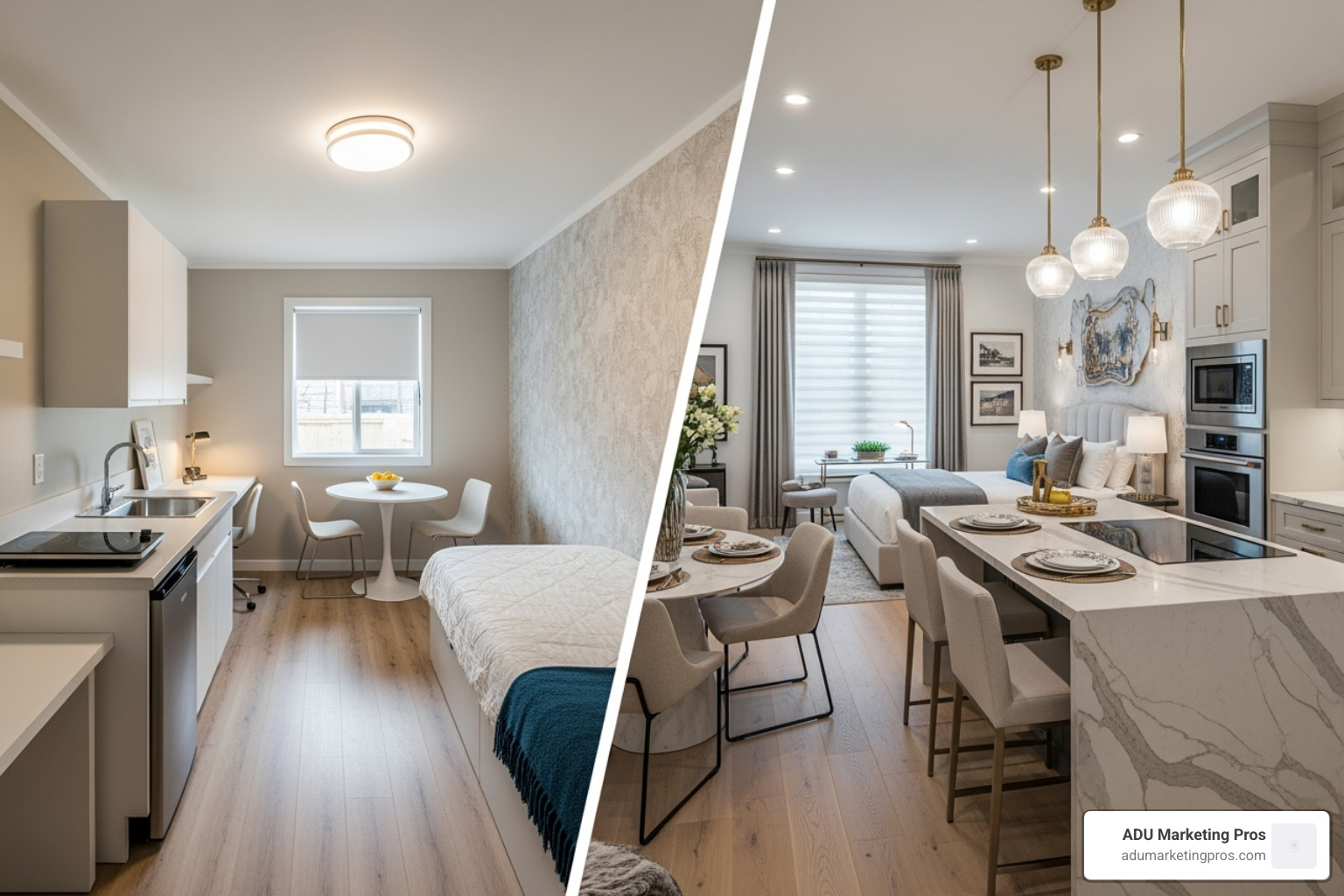
Location, Location, Regulation
Your property’s address is one of the most significant cost drivers. Labor rates and material costs vary dramatically across California; for instance, the Bay Area ADU Cost is notoriously higher than in the Central Valley or Inland Empire due to higher wages and demand. Beyond market rates, local regulations play a huge role. Navigating California ADU Regulations and city-specific ADU Zoning Laws is crucial. Some jurisdictions may have specific requirements for fire-rated materials in high-risk zones, mandate certain aesthetic standards, or have complex rules for building on sloped lots, all of which can add thousands to your budget.
Condition of the Existing Garage
The structural health of your garage is a critical cost variable. A newer, well-maintained structure is a dream starting point. However, many older garages hide expensive problems. A thorough pre-construction inspection should look for:
- Foundation Issues: Are there significant cracks, signs of settling, or evidence of water intrusion? A cracked or unlevel foundation may need extensive repairs or even a new slab poured on top.
- Structural Integrity: Is the framing wood rotted or damaged by termites? Are the walls plumb and the roof structure sound? Addressing these issues is mandatory to meet building codes.
- Hazardous Materials: Was the garage built before 1978? It could contain lead-based paint or asbestos, which require costly professional abatement.
- Outdated Systems: An old garage may have no plumbing and inadequate electrical wiring that can’t support a dwelling. Upgrading these systems is a given, but the extent of the work depends on the starting point.
Size, Layout, and Level of Finish
These are the variables where you have the most direct control over the budget.
- Size and Layout: While larger units have a higher total cost, the cost per square foot often decreases as fixed expenses are amortized. A simple, open-concept studio layout with one bathroom is significantly cheaper to build than a complex one-bedroom unit with multiple interior walls, doors, and corners. Our Custom ADU Blueprints can help you find a design that balances your needs with cost-effectiveness.
- Level of Finish: Your taste in finishes can swing your budget by tens of thousands of dollars. The kitchen and bathroom are the most expensive areas. A budget-conscious approach might use stock IKEA cabinets, laminate countertops, and vinyl plank flooring. A mid-range project might feature semi-custom cabinets, quartz countertops, and tile backsplashes. A high-end luxury ADU could include fully custom cabinetry, premium stone countertops, and high-end appliances. This is the easiest area to scale your spending up or down to meet your target budget.
The Payoff: Financial Benefits and ROI of Your Garage ADU
It’s crucial to view the ADU conversion cost not as a mere expense, but as a strategic investment in your financial future. A garage ADU is a multifaceted asset that boosts your property value, generates a steady stream of passive income, and provides invaluable lifestyle flexibility for your family.
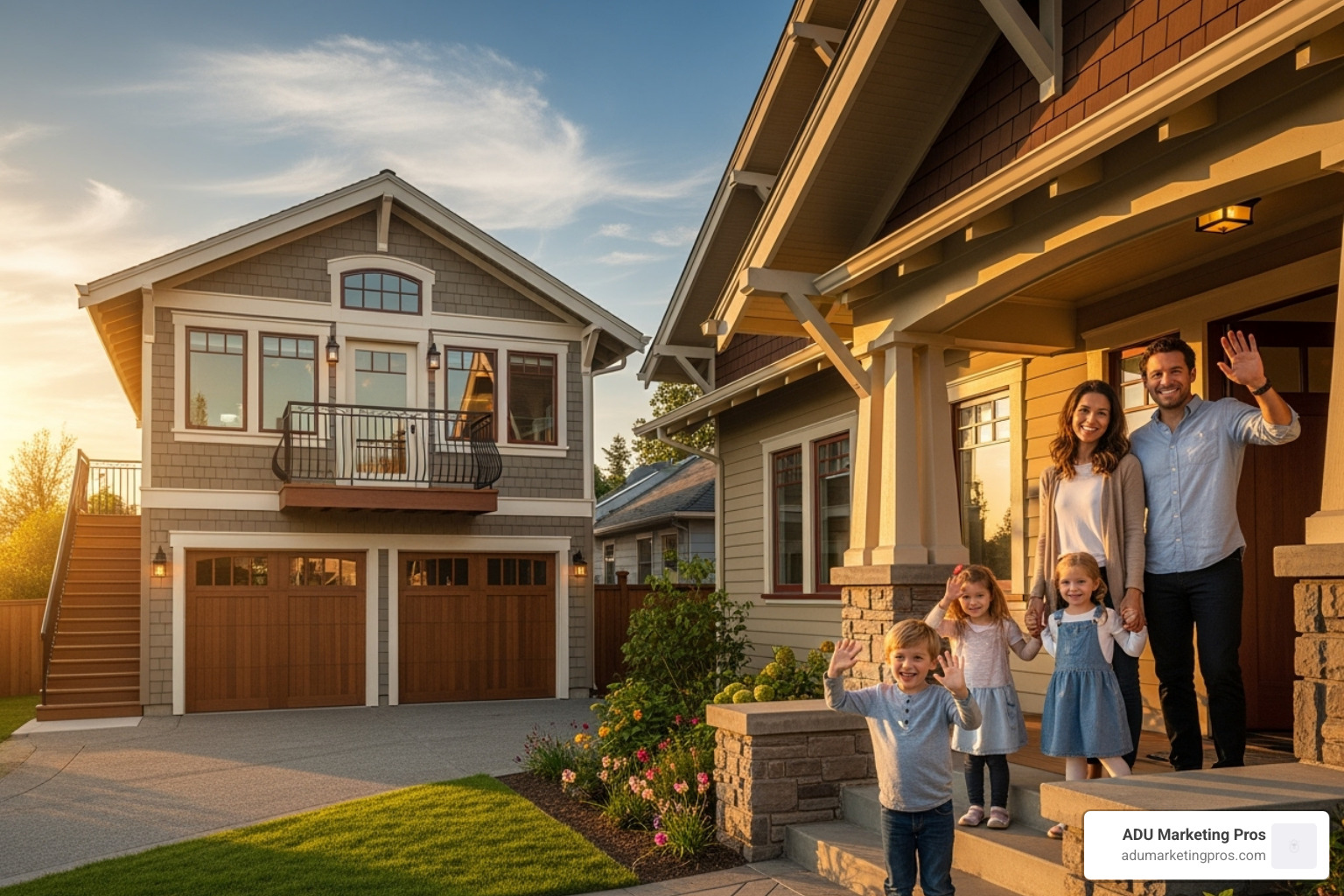
Boosting Your Property Value
Adding a legal, permitted ADU is one of the most reliable ways to increase your home’s market value. The financial impact is significant:
- Home Value Increase of 20-30%: Real estate experts and appraisers consistently find that adding an ADU can boost a property’s value by 20-30%. This isn’t just the cost of construction; it’s the added value of a second, legal dwelling unit on a single lot.
- Enhanced Market Appeal: In today’s market, properties with ADUs are highly desirable. They attract a wider pool of buyers, including those looking for rental income to offset their mortgage, families needing space for multi-generational living, or professionals seeking a dedicated home office.
- Long-Term Equity Growth: Your ADU becomes part of your property’s equity. As property values in your neighborhood appreciate over time, the value of your ADU grows with them, compounding your initial investment.
Generating Passive Rental Income
An ADU can quickly transform from a construction project into a reliable source of passive income that works for you every month.
- Typical Rental Rates: Depending on your location, the ADU’s size, and its level of finish, you can generate $1,200 to $3,000+ in monthly rent. In high-demand areas like the Bay Area or West Los Angeles, these figures can be even higher.
- Rapid Payback Period: With steady rental income, many homeowners can recoup their entire initial investment in as little as 5 to 7 years. After that, the income becomes pure profit, significantly improving your cash flow.
- Flexible Rental Strategy: You can choose a stable, long-term tenant for consistent monthly income or, where local laws permit, use the unit as a short-term rental on platforms like Airbnb for potentially higher, though more variable, returns.
Financing Your Garage Conversion
Several excellent financing options are available to cover your ADU conversion cost. Our comprehensive guide on ADU Financing Options provides more detail, but here are the most common paths:
- Home Equity Line of Credit (HELOC): A flexible line of credit you can draw from as needed. Pros: You only pay interest on what you use. Cons: Interest rates are often variable. Learn more from the Consumer Financial Protection Bureau.
- Cash-out Refinance: You refinance your existing mortgage for a larger amount and take the difference in cash. Pros: You get one single mortgage payment and often a low fixed interest rate. Cons: You are resetting your mortgage term.
- Construction Loan: A short-term loan specifically for building projects. Funds are disbursed in stages as work is completed. Pros: Tailored for construction. Cons: Can have higher interest rates and a more complex approval process than other options.
- Renovation Loan (FHA 203k): This government-insured loan allows you to finance both the purchase of a home and the cost of its renovations, or to refinance and fund a project like an ADU conversion.
- Personal Loan: An unsecured loan that is a fast option for smaller projects, though typically with higher interest rates.
Smart Savings: Strategies to Manage Your Garage Conversion Budget
With thoughtful planning and strategic decision-making, you can effectively manage your ADU conversion cost without compromising on quality or functionality. The most impactful strategies involve a realistic assessment of your DIY capabilities and a clear understanding of the inherent financial advantages of a conversion over new construction. Our Garage Conversion to ADU resource offers even more money-saving tips.
DIY Efforts vs. Hiring a Professional
Putting in some “sweat equity” can lead to substantial savings, but it’s crucial to be realistic about your skills and the risks involved. You can potentially save thousands by handling tasks like interior demolition, painting, landscaping, installing flooring, or assembling pre-fabricated cabinets. However, critical systems like electrical, plumbing, and structural work (including foundation and framing) are not DIY projects. These tasks require licensed professionals who understand complex building codes and safety standards. Attempting this work yourself can lead to failed inspections, dangerous living conditions, and costly rework that erases any initial savings. Hiring a reputable general contractor provides invaluable project management, ensures code compliance, and protects you from liability.
Smart Material & Design Choices
- Standardize Everything: Opt for standard-sized windows and doors. Custom sizes are significantly more expensive.
- Stock vs. Custom: Choose stock kitchen cabinets and bathroom vanities from retailers like IKEA or Home Depot over custom-built options.
- Durable, Affordable Flooring: Luxury Vinyl Plank (LVP) offers the look of hardwood at a fraction of the cost and is extremely durable and waterproof.
- Salvage and Reclaim: Check local salvage yards for unique items like doors, light fixtures, or even hardwood flooring at a deep discount.
Comparing the ADU Conversion Cost to New Construction
From a purely financial standpoint, garage conversions offer a clear and compelling advantage. They typically cost 40-50% less than building a new detached ADU. This massive savings comes from reusing the existing foundation, structural frame, and roof—three of the most expensive line items in any new build. The significantly shorter construction timeline also translates directly into lower labor costs.
| Comparison Point | Garage Conversion ADU | New Detached ADU |
|---|---|---|
| Typical Cost Range | $50,000 – $150,000 | $110,000 – $285,000+ |
| Cost Per Square Foot | $150 – $300 | $162 – $682 (average $305) |
| Foundation Needs | Reuses existing slab | Requires new foundation |
| Utility Connections | Simpler (attached) or moderate trenching | Requires extensive new trenching |
| Construction Timeline | 4-8 weeks | 3-6 months |
| Permitting Complexity | Generally simpler | More complex, more inspections |
| Design Flexibility | Limited by existing footprint | Fully customizable |
While new construction offers total design freedom, garage conversions provide an unbeatable combination of cost-effectiveness, speed, and return on investment. If budget and a quick path to rental income are your primary concerns, a conversion is almost always the smarter financial choice.
Frequently Asked Questions about ADU Conversion Costs
Here are detailed answers to some of the most common questions homeowners have about the ADU conversion process, timeline, and costs.
How long does a garage conversion to an ADU take?
The entire process, from initial idea to move-in ready, typically takes 4 to 6 months. This timeline can be broken down into three distinct phases:
- Planning & Design Phase (2-8 weeks): This is where you work with a designer, architect, or design-build firm to finalize your floor plans, elevations, and construction details.
- Permitting Phase (2-12 weeks): This is often the most unpredictable part of the timeline. You submit your completed plans to your local city or county building department for review and approval. The duration depends heavily on how busy the department is. Our guide to the ADU Permit Process can help you prepare for this stage.
- Construction Phase (4-8 weeks): The actual build-out is relatively fast. Because you are modifying an existing structure rather than building from scratch, the construction timeline is much shorter than for a new ADU.
Do I need an architect for a garage conversion?
While you might not always need a licensed architect, you will absolutely need a full set of professional, code-compliant plans to submit for permits. These can be created by an architect, a building designer, or a draftsperson. An architect (who typically charges 10-15% of the project cost) is recommended for complex projects involving significant structural changes or adding a second story. A building designer is often more affordable and perfectly suitable for most standard conversions. Their expertise is crucial for creating a functional layout and navigating the complex building codes, which prevents costly errors and streamlines the permitting process.
How does converting a garage affect my property taxes?
This is a critical question. Converting your garage into a permitted ADU will trigger a property tax reassessment, but it’s not as scary as it sounds. California’s Proposition 13 protects your main home’s existing assessed value. The tax assessor will not reassess your entire property. Instead, they will perform a “blended assessment.” This means they will only assess the value of the newly added construction (the converted garage) and add that new value to your existing tax basis. For example, if your home is assessed at $500,000 and the conversion cost $100,000, your new assessed value might be around $600,000, not the new market value of the entire property. The resulting tax increase is typically modest and is far outweighed by the rental income and property value gains.
Does converting a garage to an ADU require replacing parking?
Good news for most California homeowners: the answer is no. State law, updated to encourage ADU production, now exempts most projects from any parking replacement requirements. Your project is highly likely to be exempt if it is:
- A conversion of an existing structure (like a garage or accessory building).
- Located within a half-mile of public transit (bus or rail).
- Located in a designated historic district.
Even in the rare case that parking is required, the rules are flexible, often allowing tandem parking in your existing driveway. These changes have made garage conversions more feasible and affordable for millions of homeowners. For specifics on your property, consult our ADU Building Requirements guide.
Conclusion: Is a Garage Conversion a Smart Investment?
The evidence is overwhelmingly clear: a garage conversion is one of the most intelligent and lucrative investments a modern homeowner can make. While the upfront ADU conversion cost of $50,000 to $150,000 is significant, the financial returns are powerful and multifaceted. You are not just adding a room; you are adding a second, legal dwelling to your property. This can increase your total property value by an incredible 20-30% while simultaneously generating a new stream of rental income that could lead to a full payback on your investment in just 5-7 years.
Financially, garage conversions are a clear winner over new construction, coming in around 40% cheaper and being completed in a fraction of the time. By leveraging your existing structure, you save tens of thousands on foundation, framing, and roofing costs, fast-tracking your path to profitability and lifestyle enhancement. Whether you use the space for aging parents, adult children, a dedicated home office, or as a rental unit, the flexibility it provides is invaluable.
The key to a successful and cost-effective project lies in diligent research and informed decision-making. A thorough assessment of your garage’s condition, careful selection of finishes to match your budget, and a clear understanding of local regulations are the cornerstones of a smooth process. While the journey has its complexities, the destination—dramatically increased property value, substantial passive income, and enhanced living options—makes it one of the most rewarding home improvement projects available today.
For ADU professionals aiming to connect with these motivated homeowners, demonstrating this level of expertise is crucial. If you’re looking to grow your design or construction business, consider how local SEO for architects in California can help you reach qualified prospects in your area.
To learn more about statewide guidelines and resources, visit the official California Department of Housing and Community Development: ADU Resources. With the right planning and the right team, your garage can be transformed from a forgotten space into one of your best-performing assets.

